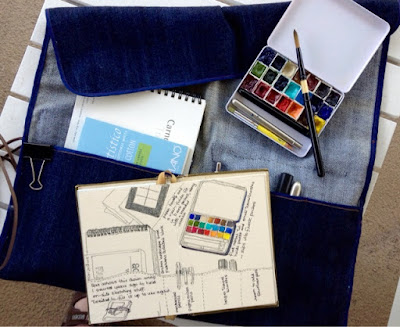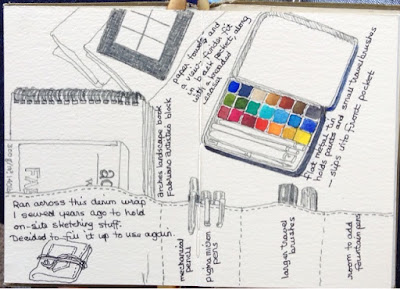 |
| Some examples of simple round back spine journals. |
A couple months ago I offered my first online bookmaking class. People have been asking me to do an online bookbinding class for years, but I've always pooh-poohed the notion.
I would tell people, "I like to be hands on." Or I would say "I like to see the students' faces when I explain things, so I can see if they don't get something."
All those things are still true, but a shoulder injury which made it impossible for me to lug my "portable" binding studio around finally convinced me I should give it a go.
So I started with what I think is an elegant and useful book for visual journal keepers (because of course that's most of the people I know).
I taught my simplified version of the round back spine. I required specific papers and materials—so that if something went awry for someone, I knew I had controlled as many variables as possible and I would be able to help them "remotely," instead of in person.
And then I made a LOT of videos. (Over five and a half hours of videos.)
One of the great things about the videos is that everyone could see equally well every step of the process. The one downside to teaching in person is that when I demonstrate there are usually 12 people in a class, huddled all around me, vying for a good vantage point. And often there is only one opportunity to watch me do something. And I push people really hard in class because I want to get them over the idea of "perfect" and instead focus on the idea of process and the whole. (I'm bossy.)
With online classes people can watch the videos over and over and the videos include so many close-ups that this is one aspect of online that's actually better than being there in person.
Of course I spent so much effort on making the videos to the point and tightly edited, that what was missing, when I sat back and watched it all was obvious—all those lengthy digressions (some of which are humorous) I'm known for. (In fact one of my pre-release testers made this actual comment since she'd taken the class with me in person.)
So I made some more videos to capture some of those digressions.
And yes people don't get to see how "funny" I am in person, but I even addressed that by having 4 live webinars where students got to see me answer their questions in real time and be impromptu and a little goofy.
Since I had no idea how to "manage" my time involvement—I seem constitutionally unable to not respond to student questions—I limited my involvement to the first month. Then I set about popping in daily and answering questions as they came up, so people could keep working.
This worked great because some students dove right in and had a book finished before the first weekend was up, while other students did each of the steps in a slightly more spaced out fashion in between the demands of their lives. That second group were able to benefit from the questions asked by the first group of students.
By the end of the first few days I realized that yes I can get across all the important points through video. It would have been nice to stand next to a couple people who were tearing paper and having problems, but I've been doing this for so long that I had lots of suggestions for them and they all reported improvement after trying different things.
That was actually the best thing about the class, the students were great. They asked great questions, they supportively commented on their fellow students' work, and they jumped right in and got their books made. And I felt comfortable working with them, because I got to do what I love to do—answer questions and teach people how to make books that they can actually use to meet their needs and they way they work.
I enjoyed the process so much that I immediately started shooting videos for 4 more book structure classes and a drawing class. As you can imagine, it takes quite a lot of time to shoot and then edit video. This is a bit frustrating for someone who writes as quickly as I do. When preparing for an in-person class I could write a handout, do a sample in the days before class to remind myself of the process' quirks so I'd be sure to mention them all, and then start packing and shifting stuff.
I guess I can live without the packing and hauling of stuff! And now I know that there are people all over who right now are working on their July book. I told them I wanted them to make a book a month for the year, to really train their minds and hands to do this process. They know I can check on them!
I have been asked when I might offer this class again. I wish I could give a concrete date. I want to release a couple other classes first because 1. I like to do new things, and 2. I want to see which types of classes are most popular. I have well over 75 classes that I'd like to translate to video, if the classes prove popular online. But as with any new venture you need to see what people like and don't.
I only teach one way, however, and that's with involvement and precision. So far the students have told me they liked it. One particularly inquisitive and delightful student told me it was like having a daily conversation with Roz—well for him it was, because he asked a lot of great questions.
My production schedule has been disrupted a couple times in the past few months as my 93-year-old father-in-law has gone in and out of hospital. He's frail, and now totally forgetful, but he has some great days. And he is very interested in what I'm teaching online.
"How can you even teach drawing online?" he asked, when I told him I had started putting together a drawing class for online.
I looked at him for a moment and considered how I could explain it. I've been teaching binding and art classes for over 25 years and it's just something I do, like paint in my journal. It seems natural to me. Teaching is something I've always done. So how could I give him a concise expression of the process of teaching a subject he has never dabbled in?
But it was immediately obvious to me. He's an engineer. I've lived my entire life with engineers (or scientists and process-oriented artists).
"You know when you were first learning to be an engineer you had to learn first principles?"
"Yep."
"Well there are those for artists as well. And a new vocabulary, just like engineering. And there are processes, which you can break down and explain so that people understand how to run a problem independently."
His eyes lit up. He knows all about learning something so well that he can improvise and create. He did it his entire life as an engineer and on his best days he still sits down at his computer and works on his pet projects.
"Well that's worth doing," he said.
And I nodded. I believe it is.
Right now I'm looking forward to the launch of
"Drawing Practice: Drawing Live Subjects in Public." It's based on a couple Drawing Practice classes I've done in person over the years. However, when I started doing the videos it became something much richer. Things that were normally one minute asides in class, discussed quickly before we pushed on to some "have to get done task," became their own entity. It was a fun experience to see this happen.
The class deals with five things I believe are critical in developing one's drawing skills for live subjects—daily practice, habit building, understanding fundamentals so well you can improvise, actually getting out in public, and dealing with one's internal critic. The class starts on July 24, 2015. There are new lessons every Tuesday and Friday through August 22. (Students have access to the videos and course materials for a year.)
I will probably offer this class again sometime in 2016, but am not sure of the schedule. Right now I plan to post another book structure class, a visual journaling class, and repeat
"Simple Round Back Spine," first. People are always asking if I'll teach a gouache class and a color theory class—yes, and yes. But they won't be ready at least until the fall of 2016 or later.
If you're interested in taking online classes with me you can go to my blog
Roz Wound Up. There you can see a "Classes with Roz" image in the left-hand column. (If you click on it you'll go to a page about the most current class.) Just below that image is a sign up form. If you sign up there you'll be fed automatically to my class mailing list and receive promotions that way.
Alternately you can go to my blog and scroll down the left column to the Category list and click on Classes. OR you can scroll down a bit more to PAGES and find the pages that say "Classes…" and click on one that appeals to you.
There are a lot of things that I'm still coming to grips with in online teaching: where to store all this video "footage" for one thing! But as with the other teaching I've done in my life, it has introduced me to interesting and creative people who want to learn. These students push me to think about my process in a meaningful way. I am grateful for that.






